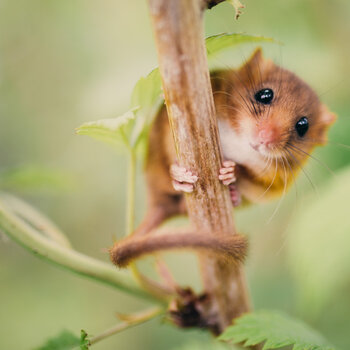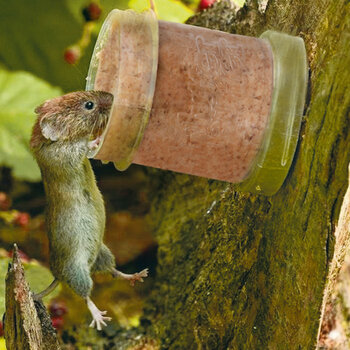

Small Rodents
- The smallest British rodent is the harvest mouse. Adults weigh just 6 grams, the same as six small paper clips.
- Our largest native rodent is the beaver. Populations survived until the 12th century in Wales and the 16th century in Scotland. Today there are feral populations in England and Scotland.
- The most widely spread small mammal in the British Isles is the wood mouse, found throughout the mainland and Ireland and on almost all offshore islands but it avoids mountainous areas.
- The wood mouse is successful because it is highly adaptable and opportunistic. It is found in most habitats, from arable land to hedgerows, but principally in woodland.
- The yellow-necked mouse will share its habitat with the wood mouse but has a more restricted range. It is found in southern England, parts of East Anglia and Wales but is absent from the north and west.
- Both wood and yellow-necked mice are agile climbers and attracted to bird feeders which they usually raid at night.
- Mice are often confused with voles, especially since the two often occur in the same habitat. Voles typically have more rounded faces and noticeably shorter tails.
- Bank voles climb hedgerow trees but are much less arboreal than wood mice. Intriguingly male bank voles are more likely to climb than females.
- The field vole is widely distributed in mainland Britain but absent from Ireland.
- Though the ranges of field and bank voles overlap, the former favour habitats with thick grass cover while the latter prefer woodland.
- Voles are an important part of the diet of many predators from foxes to owls. It is estimated that field voles are 40% of a barn owl’s diet while the most important predators of bank voles are tawny owls and weasels.
- Once water voles were found widely throughout mainland Britain but today the population is much reduced due chiefly to predation by introduced North American mink. Where mink are controlled, populations have re-established.
- The islands of Orkney and Guernsey have their own vole called Microtus arvalis or the common vole. It is widespread on the continent but probably introduced to these islands many hundreds or even thousands of years ago.
- The brown rat is perhaps the least popular of our small mammals. It is not native but reached Britain in the early 18th century from Central Asia.
- Brown rats reproduce throughout the year, breeding first at three to four months old and then producing up to five litters a year, each with as many as a dozen young.
- The smaller black rat was once widely distributed in Britain but today is very rare, mainly restricted to dockside warehouses and a few offshore islands. It is the species that spread the plague or “black death”.
- Many of us recognise a hazel dormouse but few have seen one in the wild. This is because they are small, nocturnal, and arboreal. They are also quite rare, restricted mainly to woodland in southern counties of Britain. There are no dormice in Scotland or Ireland.
- The presence of dormice is best detected by finding hazel nuts they have opened. They leave a smooth, round hole in the shell with tooth marks around the inside edge. Wood mice leave their tooth marks across the edge of the hole.
- It takes a dormouse twenty minutes or more to gnaw into a hazel nut.
- In the Chilterns the introduced edible dormouse is common and makes itself unpopular by invading lofts where it is noisy and destructive. It is much bigger than a hazel dormouse and closer in size to a squirrel.
- The edible dormouse was reputedly a favourite food of the Romans - hence its name.

